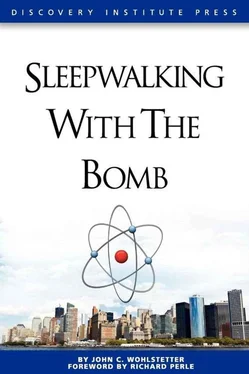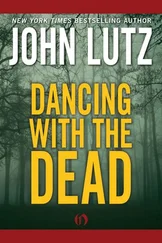John Wohlstetter - Sleepwalking with the Bomb
Здесь есть возможность читать онлайн «John Wohlstetter - Sleepwalking with the Bomb» весь текст электронной книги совершенно бесплатно (целиком полную версию без сокращений). В некоторых случаях можно слушать аудио, скачать через торрент в формате fb2 и присутствует краткое содержание. Город: Seattle, Год выпуска: 2012, ISBN: 2012, Издательство: Discovery Institute Press, Жанр: История, military, Политика, Публицистика, на английском языке. Описание произведения, (предисловие) а так же отзывы посетителей доступны на портале библиотеки ЛибКат.
- Название:Sleepwalking with the Bomb
- Автор:
- Издательство:Discovery Institute Press
- Жанр:
- Год:2012
- Город:Seattle
- ISBN:978-1-93659-906-6
- Рейтинг книги:3 / 5. Голосов: 1
-
Избранное:Добавить в избранное
- Отзывы:
-
Ваша оценка:
- 60
- 1
- 2
- 3
- 4
- 5
Sleepwalking with the Bomb: краткое содержание, описание и аннотация
Предлагаем к чтению аннотацию, описание, краткое содержание или предисловие (зависит от того, что написал сам автор книги «Sleepwalking with the Bomb»). Если вы не нашли необходимую информацию о книге — напишите в комментариях, мы постараемся отыскать её.
RICHARD PERLE, Resident Fellow, American Enterprise Institute and Assistant Secretary of Defense, 1981–1987 Sleepwalking with the Bomb
Sleepwalking with the Bomb — читать онлайн бесплатно полную книгу (весь текст) целиком
Ниже представлен текст книги, разбитый по страницам. Система сохранения места последней прочитанной страницы, позволяет с удобством читать онлайн бесплатно книгу «Sleepwalking with the Bomb», без необходимости каждый раз заново искать на чём Вы остановились. Поставьте закладку, и сможете в любой момент перейти на страницу, на которой закончили чтение.
Интервал:
Закладка:
General Douglas MacArthur—who himself had publicly excluded South Korea from the sphere of vital American interests on March 14, 1949—took back the southern half of the peninsula and decided to press onward, crossing the 38th parallel and eventually reaching the North Korea–China border. MacArthur, who viewed nuclear weapons as a legitimate military option, calculated that a nuclear-armed United States need not fear Chinese intervention. Paul Nitze, then President Truman’s national security adviser, saw cable traffic indicating that Mac-Arthur’s goal was to invade China, overthrow Mao Zedong, and restore Chiang Kai-Shek to power. Nitze noted that MacArthur had no idea how small the U.S. nuclear arsenal was in 1950. [22] The Natural Resources Council Database (accessed August 21, 2011) estimates that the U.S. stockpile of nuclear weapons was 369 in 1950 and 640 in 1951. These are year-end totals. Only a small fraction of stockpiled weapons was actually deployed and thus ready for use. In his centennial history of AT&T, Telephone , historian John Brooks writes that production of nuclear weapons went into high gear in 1951, after the desperate government had turned to the Bell System for its managerial expertise. Bell Laboratories took over management of the Sandia facility on November 1, 1949, at which time atomic bomb production was minimal. Russia’s first A-test supplied urgency. From one new design in 1948, two in 1949, and three in 1951, production increased to many designs starting in 1952. A key factor in speeding up bomb design production was the new availability of computing power.
On October 7 the UN authorized combat operations inside North Korea, as the Truman administration adopted reunification of North and South as a war aim. But catching MacArthur by surprise, the People’s Republic of China (like North Korea, neither a true people’s government nor a republic) entered the war on October 23. Its confrontation with the UN-led army was the first direct military engagement between American and Communist troops, an initially disastrous one for the Americans. China had 4 million men under arms, dwarfing the UN forces.
It is a common misperception that MacArthur’s decision to go to the Yalu River was the reason that China entered the war. In fact, Henry Kissinger writes, the triggers were American forces becoming engaged in combat on July 5, plus the Seventh Fleet’s “neutralizing” the Taiwan Strait, a move designed to preclude a Chinese invasion of Taiwan. For Mao, any American presence in the Korean Peninsula was an intolerable provocation, engendering Chinese historical fears of encirclement.
In Chinese dictator Mao Zedong, MacArthur faced a ruthless adversary utterly indifferent to massive loss of life. In discussing the prospect of a nuclear war, Mao remarked: “We may lose more than 300 million people. So what? War is war.” Although America’s nuclear weapons status did not deter Chinese aggression, the existence of nuclear weapons was not without strategic weight during the conflict. On August 5, after only six weeks of war, Truman had approved sending 10 B-29s armed with A-bombs to Guam for possible use in Korea. (Only nine planes made it, one having crashed.)
Chinese leaders knew of the American cache of atomic weapons stored on Okinawa. On November 30, 1950—a month after American forces were attacked by Chinese “volunteers” and shortly before the American retreat began—President Truman refused to rule out use of the atomic bomb in Korea. Yet Truman announced just eight days later that he would not use atomic weapons without first consulting with Great Britain, a key partner in the Korean War coalition. Then on April 6, 1951, Truman authorized General Hoyt Vandenberg to be his deputy, and at his discretion to order release of the A-bombs for use in Korea.
In 1951 MacArthur, invited to address Congress after President Truman had fired him, explained: “But once war is forced upon us, there is no other alternative than to apply every available means to bring it to a swift end. War’s very object is victory, not prolonged indecision. In war there is no substitute for victory.” The Korean War ended two years later, on July 27, 1953, with an armistice but no formal peace treaty. Thus, a technical legal state of war persists to this day.
Kissinger argues that in 1950 the U.S. missed a potentially great strategic opportunity. Had MacArthur not advanced all the way to the Chinese border, but only 100 miles into North Korea, he would have taken the North’s capital, Pyongyang, and also its prime port, Wonsan; and the South would have had a 100-mile wide front to defend against Mao’s troops, instead of 400 miles along the Yalu River; the current front along the 38th parallel is 151 miles. Had that line been held it would have placed Seoul out of range of the North’s artillery, and thus made South Korea far more secure than it is today. Had the boundary been drawn there in 1945, war would have been less likely.
For his part President Eisenhower, sworn in on January 20, 1953, never intended to use the atomic bomb in the last months of the Korean War, or on any other occasion thereafter. Proof of that came on May 1, 1954, when he rejected a request from France for help in the last days of France’s war with the North Vietnamese, telling his National Security Adviser, Robert Cutler:
I certainly do not think that the atom bomb can be used by the United States unilaterally. You boys must be crazy. We cannot use those awful things against Asians for the second time in less than ten years. My God.
Thus did Eisenhower simultaneously affirm Western values and separate them from Mao’s. Later, in 1956, Eisenhower read a report estimating that in a superpower all-out nuclear exchange America would suffer at least 65 percent casualties—some 110 million out of America’s then-170 million population—and wrote in his diary: “Even if the United States were ‘victorious,’ it would literally be a business of digging ourselves out of ashes, starting again.”
North Korea’s place on the geostrategic chessboard, long underwritten by the former Soviet Union, survived the end of the Cold War and dissolution of the Soviet evil empire, because China stepped in as big-power sponsor of the North. For the first 40 years after the 1953 armistice North Korea was rarely a prime focus of concern. Periodically it would threaten its southern neighbor, and from time to time precipitate border incidents by acts of low-grade aggression.
The U.S., UK, and USSR signed the Treaty on the Non-Proliferation of Nuclear Weapons (known as the Non-Proliferation Treaty or NPT) in 1970. Grandfathering in the five self-proclaimed nuclear powers (Israel was silent)—the U.S., United Kingdom, France, USSR, and China—the treaty requires that other countries surrender the right to build nuclear weapons in return for the right to gain access to and to use nuclear materials solely for peaceful purposes. The five declared powers are eventually to totally disarm, fulfilling the treaty’s final goal of a nuclear-free world. North Korea signed this treaty in 1985.
But sometime in the early 1980s the North began a nuclear program, and in 1994 this came to the outside world’s attention. First, an International Atomic Energy Agency (IAEA) inspection of Pyongyang’s nuclear power facilities discovered illegally diverted plutonium from the Yongbyon plant, in violation of the Nonproliferation Treaty. Former President Jimmy Carter went to Pyongyang on his own to maneuver the Clinton administration into a negotiation, emerging with a preliminary bargain that froze alternate diplomatic options. That July, Kim Il-Sung died and his despot son, Kim Jong-Il, succeeded him as head of state.
In the resultant Agreed Framework accord of October 21, 1994, the United States agreed to replace the North’s graphite-moderated reactors with light-water reactor power plants, intended solely for commercial use. The U.S. hoped to move the North Korean regime towards peaceful reconciliation with South Korea and finally towards officially settling the Korean War. The spent fuel from the graphite plants was to be turned over to the IAEA and not reprocessed to extract plutonium from the nuclear waste. The U.S. agreed to ship crude oil in sufficient quantity to replace energy loss from closing the graphite plants, and to formally assure the North against U.S. nuclear threats or actual use.
Читать дальшеИнтервал:
Закладка:
Похожие книги на «Sleepwalking with the Bomb»
Представляем Вашему вниманию похожие книги на «Sleepwalking with the Bomb» списком для выбора. Мы отобрали схожую по названию и смыслу литературу в надежде предоставить читателям больше вариантов отыскать новые, интересные, ещё непрочитанные произведения.
Обсуждение, отзывы о книге «Sleepwalking with the Bomb» и просто собственные мнения читателей. Оставьте ваши комментарии, напишите, что Вы думаете о произведении, его смысле или главных героях. Укажите что конкретно понравилось, а что нет, и почему Вы так считаете.












